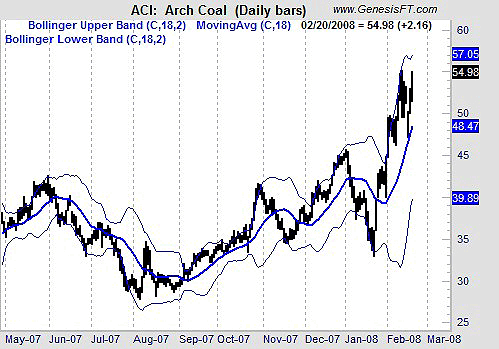
HOT TOPICS LIST
- MACD
- Fibonacci
- RSI
- Gann
- ADXR
- Stochastics
- Volume
- Triangles
- Futures
- Cycles
- Volatility
- ZIGZAG
- MESA
- Retracement
- Aroon
INDICATORS LIST
LIST OF TOPICS
PRINT THIS ARTICLE
by Mike Carr, CMT
With coal companies continuing to surge higher, now might be a good time to explore using covered call strategies.
Position: Buy
Mike Carr, CMT
Mike Carr, CMT, is a member of the Market Technicians Association, and editor of the MTA's newsletter, Technically Speaking. He is also the author of "Smarter Investing in Any Economy: The Definitive Guide to Relative Strength Investing," and "Conquering the Divide: How to Use Economic Indicators to Catch Stock Market Trends."
PRINT THIS ARTICLE
OPTIONS TRADING
Coal: Volatility And Strength
02/21/08 10:18:31 AMby Mike Carr, CMT
With coal companies continuing to surge higher, now might be a good time to explore using covered call strategies.
Position: Buy
| Covered calls are an options strategy where you hold a long position in a stock and write, or sell, call options on that same stock to generate increased income from the stock. This strategy is often employed when an investor expects the stock to have little upside over the short term. This idea is also known as a "buy-write." |
| Coal stocks were recently downgraded by analysts at Goldman Sachs, suffering significant one-day declines in reaction to the news. The next day, prices recovered and two days after the downgrade hit, some companies were trading at new all-time highs. This shows strength in an industry likely to enjoy long-term steady growth in profits. With macroeconomic factors supporting the stocks, there are good reasons to think the downgrade reflected little more than caution on the part of the analysts. |
| Arch Coal (ACI) has been one of the strongest coal companies over the past year. Figure 1 shows that the stock took a sizable hit on the downgrade but is now back to new high ground. Prices have moved up strongly in the past several months, and now look a bit overextended. The unusually wide Bollinger Bands mean that volatility has recently increased. In Bollinger On Bollinger Bands, John Bollinger writes, "High volatility begets low volatility, and low volatility begets high volatility." It is likely that we will see volatility in ACI decrease soon. |

|
| FIGURE 1: ACI, DAILY. Volatility expansion, as shown here with Bollinger Bands, can be used to identify covered call trading candidates. |
| Graphic provided by: Trade Navigator. |
| |
| That means ACI will probably need to consolidate gains at this level. Buying the stock and selling a call will allow traders to be paid while they wait for the breakout. Increased volatility means that options are steeply priced, and now is a good time to sell. Calls with a strike price of 65 offer a nice premium, and going out as far as July 2008 could mean earning as much as $3 a share for holding a stock with high relative strength. |
| If price rises above 65, the stock would be called away, leaving traders with a 23% gain in less than six months. Any decline is offset by the options premium, and the call can be sold when the stock is sold, adding to any profits taken or decreasing any realized losses. As volatility increases, options offer aggressive traders an opportunity to increase profits. |
Mike Carr, CMT, is a member of the Market Technicians Association, and editor of the MTA's newsletter, Technically Speaking. He is also the author of "Smarter Investing in Any Economy: The Definitive Guide to Relative Strength Investing," and "Conquering the Divide: How to Use Economic Indicators to Catch Stock Market Trends."
| Website: | www.moneynews.com/blogs/MichaelCarr/id-73 |
| E-mail address: | marketstrategist@gmail.com |
Click here for more information about our publications!
Comments
Date: 02/22/08Rank: 2Comment:

Request Information From Our Sponsors
- StockCharts.com, Inc.
- Candle Patterns
- Candlestick Charting Explained
- Intermarket Technical Analysis
- John Murphy on Chart Analysis
- John Murphy's Chart Pattern Recognition
- John Murphy's Market Message
- MurphyExplainsMarketAnalysis-Intermarket Analysis
- MurphyExplainsMarketAnalysis-Visual Analysis
- StockCharts.com
- Technical Analysis of the Financial Markets
- The Visual Investor
- VectorVest, Inc.
- Executive Premier Workshop
- One-Day Options Course
- OptionsPro
- Retirement Income Workshop
- Sure-Fire Trading Systems (VectorVest, Inc.)
- Trading as a Business Workshop
- VectorVest 7 EOD
- VectorVest 7 RealTime/IntraDay
- VectorVest AutoTester
- VectorVest Educational Services
- VectorVest OnLine
- VectorVest Options Analyzer
- VectorVest ProGraphics v6.0
- VectorVest ProTrader 7
- VectorVest RealTime Derby Tool
- VectorVest Simulator
- VectorVest Variator
- VectorVest Watchdog
